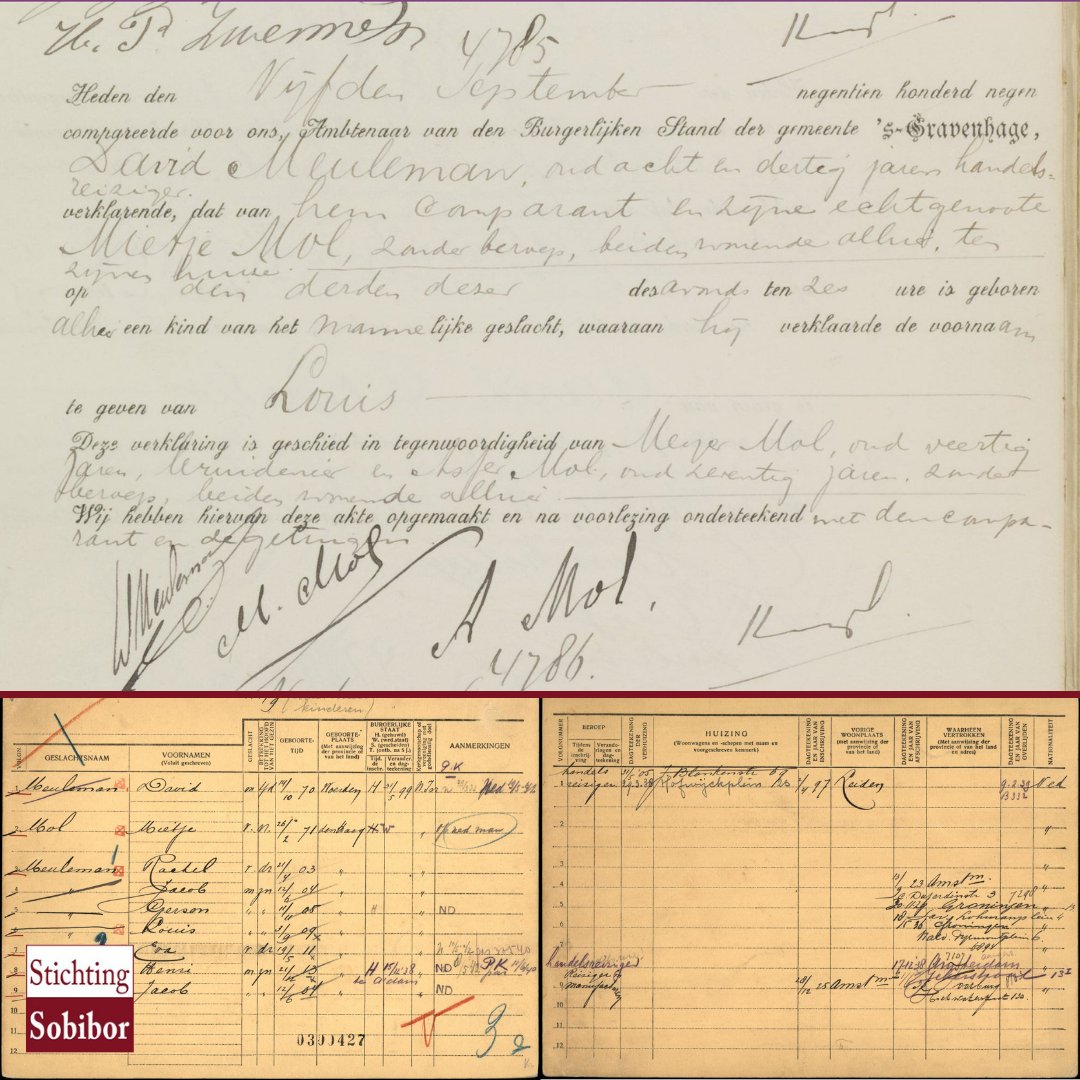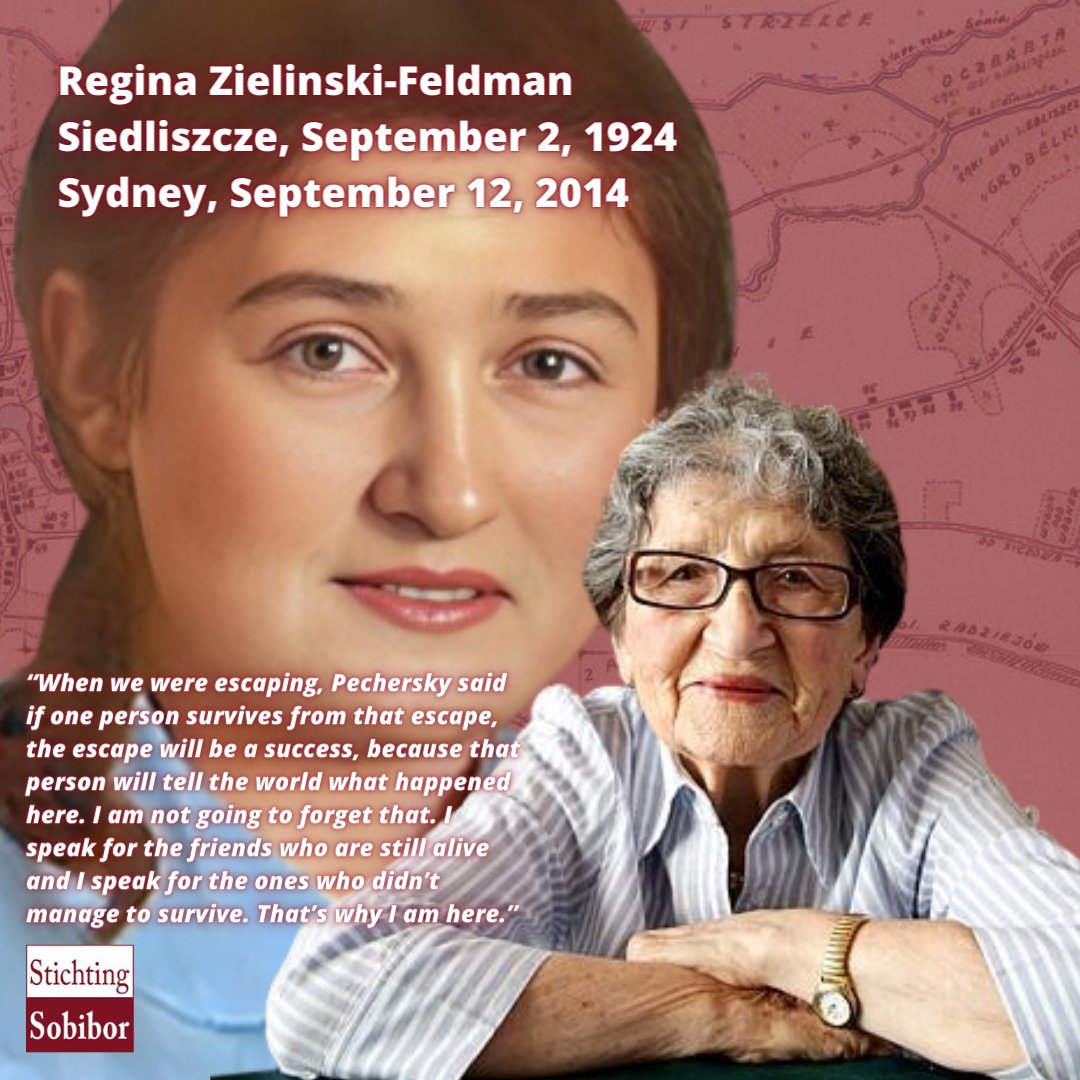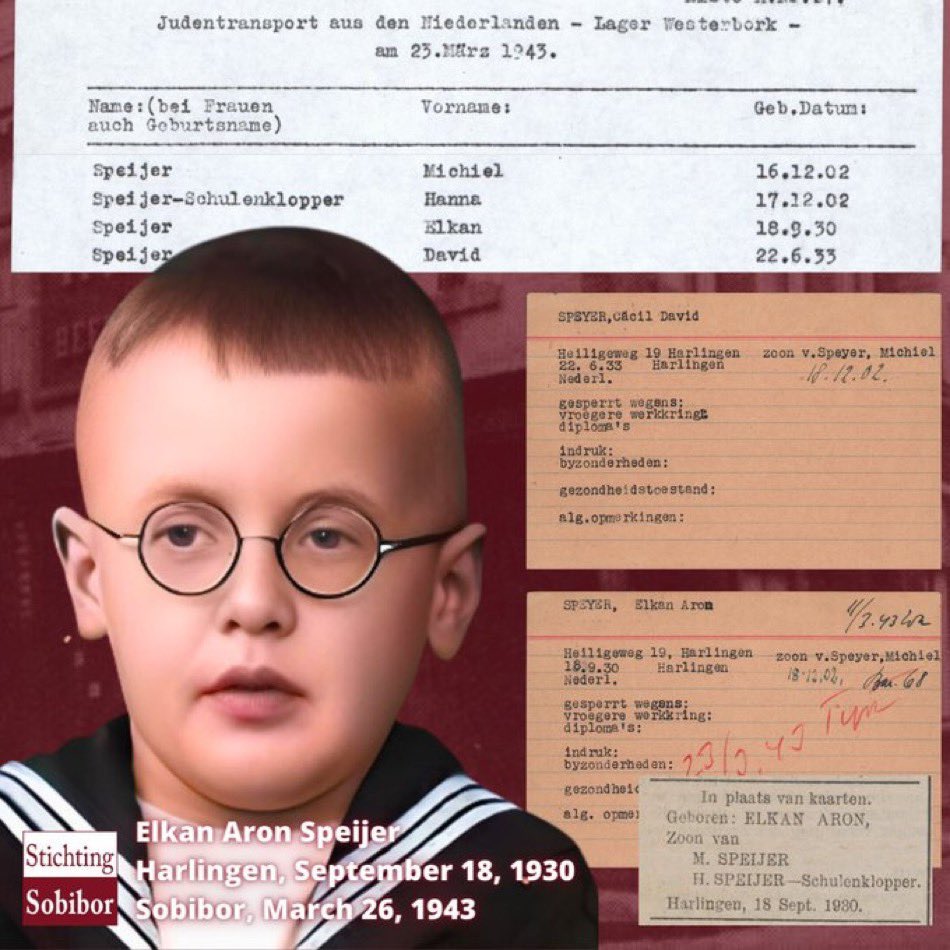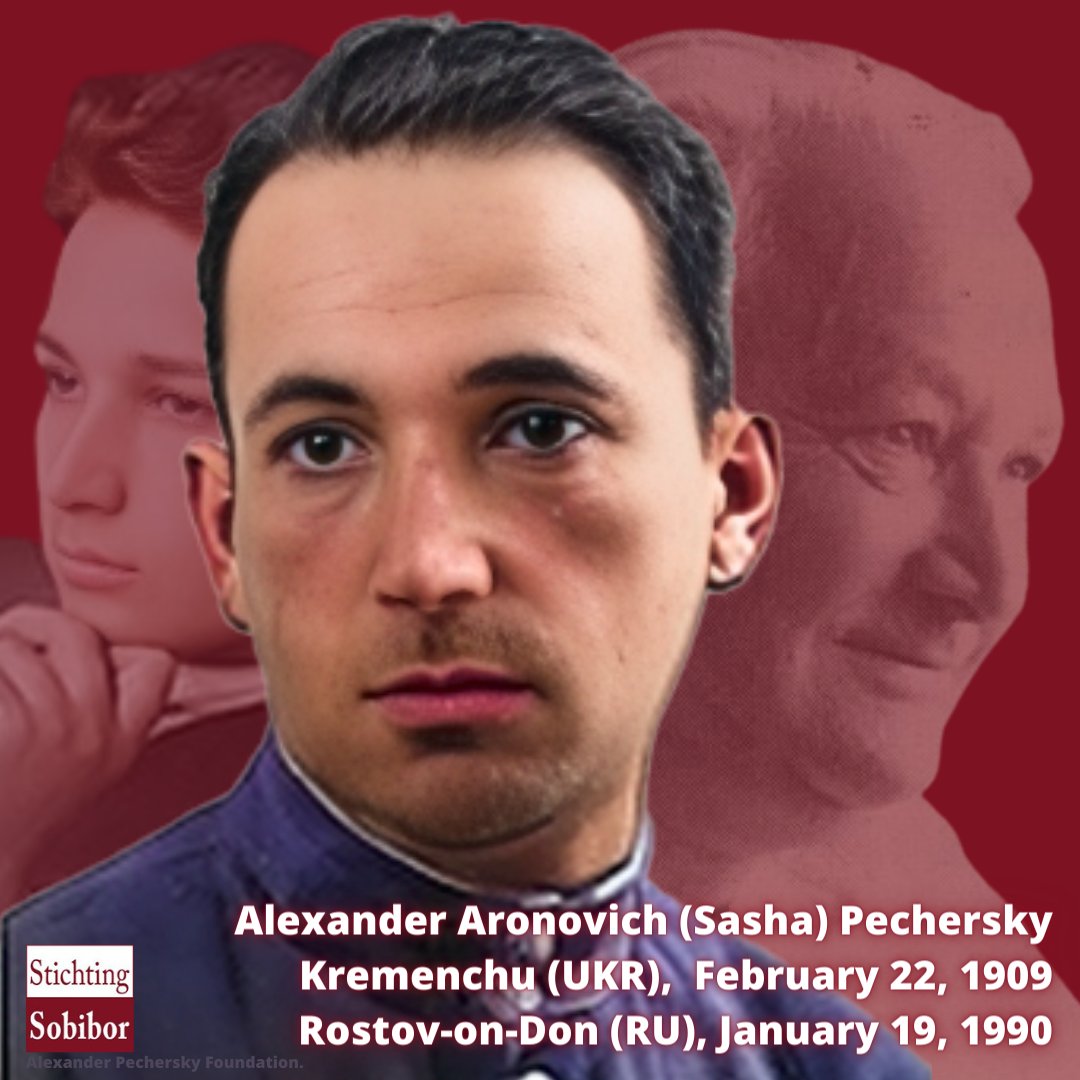
Sobibor Foundation was founded in 1999 by Jules Schelvis, survivor of death camp Sobibor in German-occupied Poland. Remember through education and information.
How to get URL link on X (Twitter) App


 2/8 Albert Rosenbaum, was born in Hamburg as a son of Samuel and Minna Rosenbaum. They had six children: Max Meier, Eduard, Albert, Else, Fred Ehrick and Gertrud. Albert and Gertrud were the only siings who did not survive the Holocaust.
2/8 Albert Rosenbaum, was born in Hamburg as a son of Samuel and Minna Rosenbaum. They had six children: Max Meier, Eduard, Albert, Else, Fred Ehrick and Gertrud. Albert and Gertrud were the only siings who did not survive the Holocaust. 

 2/7 Leni lived at Hindenburgstraße 37 in Goch. Her parents had a shop in mens/boys clothing. She was not allowed to go to kindergarten, because a mother form Goch did not want her daughter to play with Jewish children.
2/7 Leni lived at Hindenburgstraße 37 in Goch. Her parents had a shop in mens/boys clothing. She was not allowed to go to kindergarten, because a mother form Goch did not want her daughter to play with Jewish children. 

 2/7 On Aug. 18, 1930, Marianne and Sam Frank got married. The family was well-liked in Ochten, where they lived at Ambachtstraat 7 until April 9, 1943. They left their village by bus on their way to the end. The neighbors just watched. The Franks didn't want to go into hiding.
2/7 On Aug. 18, 1930, Marianne and Sam Frank got married. The family was well-liked in Ochten, where they lived at Ambachtstraat 7 until April 9, 1943. They left their village by bus on their way to the end. The neighbors just watched. The Franks didn't want to go into hiding. 

 2/7 Louis Meuleman was born September 3, 1909 in The Hague as son of David Meuleman and Mietje Mol. He had two sisters and four brothers. He grew up at Jan Blankenstraat 69 in The Hague.
2/7 Louis Meuleman was born September 3, 1909 in The Hague as son of David Meuleman and Mietje Mol. He had two sisters and four brothers. He grew up at Jan Blankenstraat 69 in The Hague. 

 2/9 2/9 Regina was forced to the Siedliszcze ghetto with her family on May 18, 1941. On Oct. 22, 1942, she was sent to Staw labor camp. Arriving in Sobibor in Dec. 1942, she was selected to sort clothes & knit socks. She later worked in the laundry, cleaning & sorting ammunition.
2/9 2/9 Regina was forced to the Siedliszcze ghetto with her family on May 18, 1941. On Oct. 22, 1942, she was sent to Staw labor camp. Arriving in Sobibor in Dec. 1942, she was selected to sort clothes & knit socks. She later worked in the laundry, cleaning & sorting ammunition. 

 2/8 On July 1, 1873 the obligation expired for William, Emilia, Clasina and Palmyra to work as contract laborers on the Petersburg sugar plantation, where they were enslaved until 1863. The English plantation owner Sir John Young had given them the surname Cambridge.
2/8 On July 1, 1873 the obligation expired for William, Emilia, Clasina and Palmyra to work as contract laborers on the Petersburg sugar plantation, where they were enslaved until 1863. The English plantation owner Sir John Young had given them the surname Cambridge. 

 2/5 Cäcil had one older brother, Elkan. Together they attended school in Harlingen. From September 1, 1942, the German occupiers required them to attend the Jewish School in Leeuwarden.
2/5 Cäcil had one older brother, Elkan. Together they attended school in Harlingen. From September 1, 1942, the German occupiers required them to attend the Jewish School in Leeuwarden. 

 2/8 Leon Felhendler was born in Turobin, Poland. His father became Chief Rabbi in Żółkiewka in 1924. Married Toba Wajnberg on May 9, 1935, and had a son, Chaim Szymon, on October 20, 1935. Limited records make it unclear about their second child.
2/8 Leon Felhendler was born in Turobin, Poland. His father became Chief Rabbi in Żółkiewka in 1924. Married Toba Wajnberg on May 9, 1935, and had a son, Chaim Szymon, on October 20, 1935. Limited records make it unclear about their second child. 

 2/10 Jozef Wins was born in Amsterdam in 1915 as a son of Isaäc Wins (1884-1942) and Bloeme Leeda (1892-1942). He had 2 brothers, Samuel (1913-1919) and Salomon (1930-1943), and 2 sisters, Rachel (1918) and Sophia (1927-1942). Rachel and Jozef both survived the war.
2/10 Jozef Wins was born in Amsterdam in 1915 as a son of Isaäc Wins (1884-1942) and Bloeme Leeda (1892-1942). He had 2 brothers, Samuel (1913-1919) and Salomon (1930-1943), and 2 sisters, Rachel (1918) and Sophia (1927-1942). Rachel and Jozef both survived the war. 

 2/10 Herman Sanders was born in Wildervank and after finishing his studies he worked at the Polak company in Groningen. Polak is the inventor of the lemonade syrup Ranja. In 1901 he became a representative for the company in Amsterdam and from 1916 he was a member of the board of directors.
2/10 Herman Sanders was born in Wildervank and after finishing his studies he worked at the Polak company in Groningen. Polak is the inventor of the lemonade syrup Ranja. In 1901 he became a representative for the company in Amsterdam and from 1916 he was a member of the board of directors.

 2/16 Sasha had a one brother Boris (1907) and two sisters, Faina (1906) and Zinaida/Zina (1921). At home, his parents spoke Yiddish. In 1915, his family fled to Rostov-on-Don, where he eventually worked as an electrician at a locomotive repair factory.
2/16 Sasha had a one brother Boris (1907) and two sisters, Faina (1906) and Zinaida/Zina (1921). At home, his parents spoke Yiddish. In 1915, his family fled to Rostov-on-Don, where he eventually worked as an electrician at a locomotive repair factory. 

 2/9 Regina Zielenski, born Riwka Feldman, was forced to move to the Siedliszcze ghetto on 18 May 1941 along with her parents, Golda and Josef Feldman, her sister Fradele, 19, and 3 brothers: Max, 21, Theodore, 13, and Paul, 10. On 22 October 1942, they were all sent to the Staw labour camp. Crammed into horse-drawn carts and guarded by SS men, Regina arrived in Sobibor just before Christmas 1942 with about 800 Polish Jews from the Staw-Nowosiulki. On arrival, an officer asked for young women who could knit. Her mother pushed her forward and she was 1 of the 11 selected. She was sent to the barracks to untangle clothes and knit socks for the German army.
2/9 Regina Zielenski, born Riwka Feldman, was forced to move to the Siedliszcze ghetto on 18 May 1941 along with her parents, Golda and Josef Feldman, her sister Fradele, 19, and 3 brothers: Max, 21, Theodore, 13, and Paul, 10. On 22 October 1942, they were all sent to the Staw labour camp. Crammed into horse-drawn carts and guarded by SS men, Regina arrived in Sobibor just before Christmas 1942 with about 800 Polish Jews from the Staw-Nowosiulki. On arrival, an officer asked for young women who could knit. Her mother pushed her forward and she was 1 of the 11 selected. She was sent to the barracks to untangle clothes and knit socks for the German army.

 2/11 Ellen was born in Amsterdam, as the daughter of Herman Sanders and Sara Maijkels. She lived in her childhood with her twin sister Vera and her younger sister Henny (1923) in De Lairessestraat in Amsterdam. In 1931 the family moved to Groningen due to her father's work. After her final exams, she returned to Amsterdam in 1938 to study at the “school for social work” in the Pieter de Hoochstraat.
2/11 Ellen was born in Amsterdam, as the daughter of Herman Sanders and Sara Maijkels. She lived in her childhood with her twin sister Vera and her younger sister Henny (1923) in De Lairessestraat in Amsterdam. In 1931 the family moved to Groningen due to her father's work. After her final exams, she returned to Amsterdam in 1938 to study at the “school for social work” in the Pieter de Hoochstraat.

 2/11 Marcus Hamme was born in The Hague in 1901. He had 3 brothers and 2 sisters, of whom only Manuel David Hamme and his wife Roosje (Ro) Koekoek survived the war. Their son John Hamme died in Mauthausen on September 16, 1941, after being arrested prior to the February 1941 strike.
2/11 Marcus Hamme was born in The Hague in 1901. He had 3 brothers and 2 sisters, of whom only Manuel David Hamme and his wife Roosje (Ro) Koekoek survived the war. Their son John Hamme died in Mauthausen on September 16, 1941, after being arrested prior to the February 1941 strike.

 2/18 Jules was born on Jan. 7, 1921, the 2nd child of Jewish parents who went through life as humanists and members of the Social Democratic Workers Party (SDAP). Some Jewish traditions were maintained. He experienced his childhood in a diamond workers' family under varying financial circumstances during the crisis years of the last century as a happy one, especially because in addition to always having bread on the table, there was a focus on culture and science.
2/18 Jules was born on Jan. 7, 1921, the 2nd child of Jewish parents who went through life as humanists and members of the Social Democratic Workers Party (SDAP). Some Jewish traditions were maintained. He experienced his childhood in a diamond workers' family under varying financial circumstances during the crisis years of the last century as a happy one, especially because in addition to always having bread on the table, there was a focus on culture and science.

 Fiszel Mak moved to Rotterdam 1927, serving the Dutch-Jewish Congregation as second hazzan (cantor) and as shokhet (ritual butcher). After the 1940 bombing, the family moved to Beukelsdijk 152a. Here they lived until April 10, 1943. 2/5
Fiszel Mak moved to Rotterdam 1927, serving the Dutch-Jewish Congregation as second hazzan (cantor) and as shokhet (ritual butcher). After the 1940 bombing, the family moved to Beukelsdijk 152a. Here they lived until April 10, 1943. 2/5 

 What was David thinking about on April 2, 1943 just before he was killed? Was it of his childhood home at 5-II President Brand Street? Was he thinking of his happy childhood in the Transvaal neighborhood? 2/7
What was David thinking about on April 2, 1943 just before he was killed? Was it of his childhood home at 5-II President Brand Street? Was he thinking of his happy childhood in the Transvaal neighborhood? 2/7 

 The Jewish Huisman family had lived in @rotterdam for almost two centuries and the family was part of the upper middle class. They owned a men's clothing store on the Hoogstraat. In 1927, Karel Huisman became a wholesaler after quitting the family business. 2/17
The Jewish Huisman family had lived in @rotterdam for almost two centuries and the family was part of the upper middle class. They owned a men's clothing store on the Hoogstraat. In 1927, Karel Huisman became a wholesaler after quitting the family business. 2/17 

 Leon Felhendler was born in Turobin, Poland. His father became Chief Rabbi in Żółkiewka in 1924. Married Toba Wajnberg on May 9, 1935, and had a son, Chaim Szymon, on October 20, 1935. Limited records make it unclear about their second child. 2/8
Leon Felhendler was born in Turobin, Poland. His father became Chief Rabbi in Żółkiewka in 1924. Married Toba Wajnberg on May 9, 1935, and had a son, Chaim Szymon, on October 20, 1935. Limited records make it unclear about their second child. 2/8 

 Sasha had a one brother Boris (1907) and two sisters, Faina (1906) and Zinaida/Zina (1921). At home, his parents spoke Yiddish. In 1915, his family fled to Rostov-on-Don, where he eventually worked as an electrician at a locomotive repair factory. 2/16
Sasha had a one brother Boris (1907) and two sisters, Faina (1906) and Zinaida/Zina (1921). At home, his parents spoke Yiddish. In 1915, his family fled to Rostov-on-Don, where he eventually worked as an electrician at a locomotive repair factory. 2/16 

 Tracing Isaac Leijdesdorff's journey: from attending the 'HBS' in Harlingen to residing at Hofstedestraat 8b, Rotterdam in 1927. It is unknown what he was doing in Rotterdam. By 1929, he returned to Harlingen, later settling in Zutphen at Kuiperstraat 14. 2/11
Tracing Isaac Leijdesdorff's journey: from attending the 'HBS' in Harlingen to residing at Hofstedestraat 8b, Rotterdam in 1927. It is unknown what he was doing in Rotterdam. By 1929, he returned to Harlingen, later settling in Zutphen at Kuiperstraat 14. 2/11 